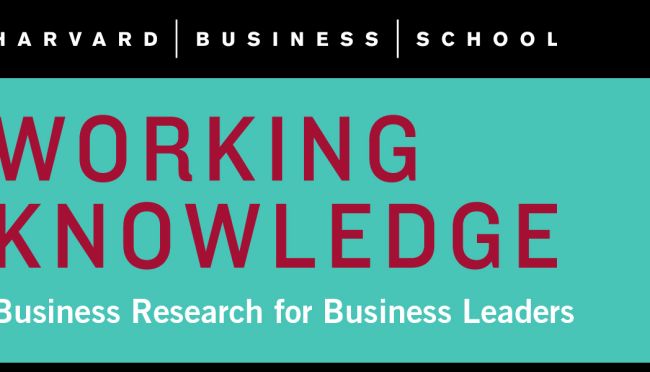Innovation and Management →
→

- 29 Nov 2022
- Research & Ideas
Is There a Method to Musk’s Madness on Twitter?
Elon Musk's brash management style has upended the social media platform, but was bold action necessary to address serious problems? Andy Wu discusses the tech entrepreneur's takeover of Twitter.

- 24 Nov 2020
- Working Paper Summaries
Accounting for Product Impact in the Consumer Finance Industry
A framework and method for measuring and monetizing product impact across industries, applying it to two competitors in the consumer finance space.

- 22 Jun 2020
- Working Paper Summaries
Iterative Coordination and Innovation
Do Agile methodologies promote innovation? Results of a field experiment with Google show that increasing the frequency and goal orientation of stand-up meetings reinforces integration and value but reduces specialization and novelty in outcomes.

- 30 Jul 2019
- Working Paper Summaries
‘Organizing’, ‘Innovating’, and ‘Managing’ in Complexity Space
This paper explores organizational complexity by proposing a two-dimensional framework to help us understand organizational coping mechanisms and failure modes. The framework makes it possible to ask new questions about organizational adaptations to complexity that investigate its underlying structure and dynamics.

- 21 May 2019
- Cold Call Podcast
If the Key to Business Success Is Focus, Why Does Amazon Work?
Sunil Gupta explores the infiltration of Amazon into dozens of industries including web services, grocery, and movie production. What’s the big plan? Is the company spread too thin? Open for comment; 0 Comments.

- 17 Apr 2019
- Research & Ideas
How Managers Stifle Creativity
3QUESTIONS: Teresa Amabile discusses the roots of creativity, how to achieve more of it, and combining it with artificial intelligence. Open for comment; 0 Comments.

- 27 Feb 2019
- Working Paper Summaries
Judgment Aggregation in Creative Production: Evidence from the Movie Industry
Selecting early-stage ideas in creative industries is challenging because consumer taste is hard to predict and the quantity to sift through is large. Using The Black List that ranks scripts annually based on nominations from film executives, this study shows that aggregating expert opinions helps reduce quality uncertainty and can influence high-budget production.

- 19 Sep 2018
- Sharpening Your Skills
Say Again? Uncommon Advice for Common Business Problems
Sometimes the right answer is far from obvious. Learn why an introvert may be the best choice to lead your team, taking a pay cut might make you a better manager, and why you should not trust your gut when the pressure is on. Open for comment; 0 Comments.

- 20 Dec 2017
- Lessons from the Classroom
How to Design a Better Customer Experience
With the help of LEGO bricks, Stefan Thomke helps business executives discover how design principles can serve as building blocks to create a great customer experience. Open for comment; 0 Comments.

- 15 May 2017
- Working Paper Summaries
Flexing the Frame: TMT Framing and the Adoption of Non-Incremental Innovations in Incumbent Firms
Organizations continuously face decisions about whether or not to adopt innovations. Often, however, senior teams do not adopt an innovation even when the organization has the resources to do so. Using real examples, this paper theorizes how the processes of cognitive and emotional framing inform managerial choices about whether or not to adopt innovations.
- 20 Mar 2017
- Book
Why Companies Are Placing Users at the Core of Their Innovation Strategies
In his recent edited volume Revolutionizing Innovation, Karim Lakhani brings together the latest thinking around open innovation, users, and communities. Open for comment; 0 Comments.
- 12 Oct 2016
- Research & Ideas
Break the Rules of How Business is Done
Making just small changes to how you do business inside and outside the company can help you attract bright employees and increase innovation, argues Julia B. Austin. Open for comment; 0 Comments.

- 03 Aug 2015
- Research & Ideas
Why Fierce Competitors Apple and Amazon Became ’Frenemies’ Over eReaders
New research by Feng Zhu and colleagues reveals why sometimes it's better for fierce competitors like Apple and Amazon to work together. Open for comment; 0 Comments.
- 04 May 2015
- Research & Ideas
Need to Solve a Problem? Take a Break From Collaborating
Organizations spend a lot of money enabling employees to solve problems collectively. But inducing more collaboration may actually hinder the most important part of problem-solving: actually solving the problem. Research by Jesse Shore, Ethan Bernstein, and David Lazer. Open for comment; 0 Comments.
- 02 Apr 2015
- Research & Ideas
Digital Initiative Summit: The Business of Crowdsourcing
Gaining the community's trust is vital to building a successful business with crowdsourcing. Open for comment; 0 Comments.
- 09 Mar 2015
- Research & Ideas
Why Entrepreneurs Should Go Work for Government
In a new Harvard Business School course on public entrepreneurship, Mitchell B. Weiss explores how fresh thinkers can work with—and within—the halls of government. Open for comment; 0 Comments.
- 02 Mar 2015
- Research & Ideas
Retail Reaches a Tipping Point—Which Stores Will Survive?
Part 1: The new book Retail Revolution: Will Your Brick and Mortar Store Survive? argues that ecommerce is about to deal severe blows to many familiar store-based brands—even including Walmart. Here's how retailers can fight back, according to Rajiv Lal, José Alvarez, and Dan Greenberg. Open for comment; 0 Comments.

- 13 Feb 2015
- Working Paper Summaries
A Methodology for Operationalizing Enterprise Architecture and Evaluating Enterprise IT Flexibility
When dealing with complex information system architectures, changes often propagate in unexpected ways, increasing the costs of adapting the system to future needs. In this paper the authors use data from a real firm and develop a robust network-based methodology by which to visualize and measure any firm's enterprise architecture. They also explore the dynamics of how different types of coupling influence the flexibility of enterprise architectures. They conclude with insights for practicing managers who must, for example, allocate resources and identify opportunities for system redesign. Closed for comment; 0 Comments.
- 05 Feb 2015
- Research & Ideas
How New BofA Executives Learn its ’Deep Smarts’
Bank of America's stringent onboarding process for new execs ensures they understand role expectations, quickly develop networks, and learn from other leaders what it takes to succeed. From the new book by Dorothy Leonard and colleagues, Critical Knowledge Transfer. Open for comment; 0 Comments.

Building an Inclusive Workplace? Prepare to Shield It from Economic Fears
Mixed economic signals have many worrying about what's to come. Distracted leaders could lose sight of their inclusion and belonging goals to the detriment of future innovation. But it doesn't have to be this way, say Hise Gibson and Nicole Gilmore.